) in clinical exercise testing?
A. Age
B. Sex
C. Lean body mass
D. Body weight (kilograms)
E. Exponent of body length
2. Which method of exercise would achieve a higher maximum oxygen uptake ( )?
)?
A. Stationary electronically braked cycle ergometer
B. Arm crank ergometer
C. Hand grip ergometer
D. Treadmill ergometer
E. Stationary mechanically braked cycle ergometer
3. Which cardiac exercise parameter has a limited increase in with exercise in the supine position early in exercise?
A. Heart rate
B. Minute ventilation
C. Stroke volume
D. Respiratory rate
E. Blood pressure
4. What cardiovascular changes would be expected during exercise?
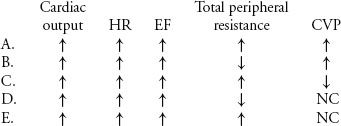
5. Which blood pressure change would be expected in a normal 15-year-old male patient (resting blood pressure = 110/72 mm Hg) with isotonic exercise?
A. 150/78 mm Hg
B. 155/55 mm Hg
C. 120/95 mm Hg
D. 170/100 mm Hg
E. 160/110 mm Hg
6. Which blood pressure change would be expected in a normal 15-year-old male patient (resting blood pressure = 110/72 mm Hg) with isometric exercise?
A. 150/72 mm Hg
B. 170/60 mm Hg
C. 120/68 mm Hg
D. 220/100 mm Hg
E. 220/70 mm Hg
7. What maximum heart rate and maximum oxygen consumption would best represent a normal 15-year-old male patient during isotonic exercise?
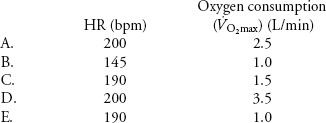
8. A healthy 21-year-old female on no medications just finished a treadmill exercise test. She exercised for a total of 6 minutes. The exercise physiologist technician questioned her effort. However, the patient claimed she “gave it her all.” What is her expected maximal heart rate?
A. 123 bpm
B. 158 bpm
C. 185 bpm
D. 189 bpm
E. 196 bpm
9. As a normal child ages, what ventilatory changes at peak exercise would be expected?
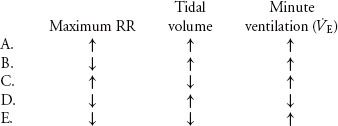
10. What cardiovascular physiological changes would be expected with improved fitness? [COMP: Please align the below answers as given below]
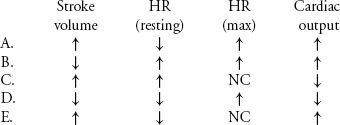
11. What physiological respiratory changes would be expected with improved fitness?

12. Which condition would be a contraindication for exercise testing?
A. Atrial septal defect with left-to-right shunt
B. Ventricular septal defect with left-to-right shunt
C. Severe primary pulmonary hypertension
D. History of myocardial infarction
E. History of rheumatic heart disease
13. Compared with the normal population, highly trained adult athletes have which of the following physiologic changes?
A. Decreased glycogen stores
B. Decreased oxidative enzyme activity
C. Increased minimum lactate
D. Decreased anaerobic enzyme activity
E. Increased triglyceride stores
14. Identify the correct statement regarding ventilatory (anaerobic) threshold (VAT).
A. The VAT is the  at which there is a disproportionate decrease in minute ventilation relative to oxygen uptake
at which there is a disproportionate decrease in minute ventilation relative to oxygen uptake
B. VAT is synonymous with the threshold for decompensated acidosis
C. There is commonly a relative drop in lactate production when VAT is reached
D. When VAT is reached, there is a decrease in mixed expired O2 concentration
E. During incremental exercise, VAT does not reflect the onset of anaerobic metabolism
15. As compared to an acyanotic patient, an unrepaired, cyanotic patient at peak exercise will exhibit a higher:
A. Heart rate
B. Ventilatory equivalent for oxygen
C. Blood oxygen saturation
D. Maximum oxygen uptake
E. Diastolic blood pressure
16. Which statement is correct regarding an optimal exercise protocol?
A. Duration of exercise test between 12 and 15 min
B. Modified Bruce protocol is appropriate for children with limited exercise capacity
C. James protocol has relatively small work increments
D. Ramp protocol has large increases in workload
E. Ramp protocol is appropriate for assessing steady-state exercise
17. Which statement is correct regarding the ventilatory response to exercise?
A. Total ventilation increases because of increased rate, while tidal volume remains constant
B. Tidal volume increases predominately by tapping into the expiratory reserve volume
C.  declines early in exercise as a result of better ventilation and blood flow matching in the lungs
declines early in exercise as a result of better ventilation and blood flow matching in the lungs
D. Normal subjects terminate exercise because ventilation can increase no further while cardiac output can continue to increase
E. Diffusion limitation is a common problem during routine clinical exercise testing
18. Which of the following exercise testing technique statements would be correct?
A. Circling 60% of the patient’s arm with the sphygmomanometer cuff
B. Sphygmomanometer cuff width equals 30% of the upper arm length
C. Using the assumption that acetylene-helium technique approximates cardiac output in a patient with a large atrial septal defect and left-to-right shunt
D. Recognizing that acetylene-helium technique is dependent on even distribution of inspired gas in the lungs
E. Using CO2 rebreathing technique in children due to better toleration than acetylene-helium technique
19. A 22-year-old male, well-trained college football athlete underwent a treadmill exercise study mid-season. Shortly thereafter, he sustained a lower limb injuring and was unable to train for 3 months during recovery. He now underwent a second treadmill exercise test at the start of re-training. Both exercise studies were maximum effort. Which data would best describe his situation?
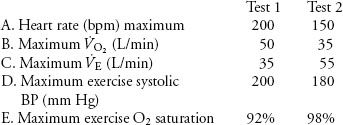
20. In a healthy 15-year-old female without lung disease who gave maximum effort on spirometry before exercise testing, which statement about maximum voluntary ventilation (MVV) is correct?
A. MVV is reliably measured as it is independent of subject effort
B. Maximal  < 70% of resting MVV suggests pulmonary limitation to exercise
< 70% of resting MVV suggests pulmonary limitation to exercise
C. MVV is ~35 to 40 times FEV1
D. MVV is typically measured during early exercise
E. MVV can also detect vocal cord dysfunction as a cause for exertional dyspnea
21. In healthy patients, which of the following is a normal physiological response during exercise?
A. Increased end-systolic volume
B. Increased diastolic pressure during isotonic exercise
C. Among similar-sized children, girls have a higher peak systolic blood pressure than boys
D. Black children have a greater blood pressure response to exercise when compared to white children
E. Blood pressure increases during exercise are due to increased systemic resistance
22. Which patient would be a good candidate for the use of acetylene-helium rebreathing technique during exercise testing for the measurement of cardiac output?
A. 15-year-old male with Epstein’s anomaly and a large secundum ASD with right-to-left shunt
B. 12-year-old female s/p Fontan operation with AV pulmonary fistulas
C. 14-year-old male with a patent foramen ovale with trivial left-to-right shunt
D. 8-year-old male with a moderate membranous VSD with left-to-right shunt
E. 10-year-old female with a persistent left SVC and unroofed coronary sinus
23. During exercise stress testing, what direct measurement can be determined by using acetylene helium rebreathing technique?
A. Systemic blood flow
B. Pulmonary oxygen exchange
C. Cardiac output
D. Shunt volume
E. Effective pulmonary blood flow
24. In a healthy, normal child, what organ system is most commonly responsible for limiting maximal achievable workload?
A. Pulmonary
B. Cardiovascular
C. Musculoskeletal
D. Neurologic
E. Gastrointestinal
25. The calculation of work can be completed with which equation?
A. Work = force × distance
B. Work = force/distance
C. Work = distance/force
D. Work = mass × acceleration
E. Work = mass/acceleration
26. Which statement about exercise testing physiology is correct?
A. An increase in stroke volume is the major determinant of an increased cardiac output during exercise in a normal patient
B. Girls, particularly after puberty, have a slightly lower heart rate when compared to boys at any given workload
C. For patients >20 years of age, maximal heart rate changes with age
D. For patients >20 years of age, maximum heart rate increase with conditioning
E. Total systemic vascular resistance increases with increase workload
27. Which of the following patients, if a maximal effort was achieved, would result in a higher maximal  during work?
during work?
A. A 17-year-old white, female who completed cycle exercise testing
B. A 17-year-old white, male who completed cycle exercise testing
C. An 18-year-old white, anemic, male who completed cycle exercise testing
D. A 12-year-old African-American, male who completed cycle exercise testing
E. A 12-year-old African-American, female who completed cycle exercise testing
28. Which of the following echocardiographic findings would be most consistent with a heart of a well-trained, normal athlete?
A. Decreased left ventricular end-diastolic dimension
B. Decreased left ventricular wall thickness
C. Decreased stroke volume
D. Increased left ventricular end-diastolic volume
E. Increased left ventricular end-systolic dimension
29. Which of the following conditions is an absolute contraindication to exercise testing?
A. Second-degree A-V block
B. Severe aortic stenosis
C. Catecholaminergic polymorphic ventricular tachycardia
D. Long QT syndrome
E. Anomalous origin of a coronary artery
30. Which of the following statements comparing treadmill exercise testing to cycle ergometry is correct?
A. Cycle ergometry derived maximum oxygen uptake ( ) is higher than treadmill testing
) is higher than treadmill testing
B. Noise and artifact is less during treadmill exercise testing
C. Cycle ergometry allows for a more accurate work measurement
D. Cycle ergometry is potentially more dangerous than treadmill ergometry
E. Younger children (4 to 6 years of age) may have more difficulty using a treadmill ergometry than a cycle ergometry
31. Which statement is most accurate with regard to aortic stenosis and exercise stress testing?
A. Total work performed has a linear relationship with transaortic pressure gradient
B. Greater increase in systolic blood pressure with exercise when compared to normal patients
C. The higher the transaortic gradient, the lower expected ST segment change during exercise
D. The higher the transaortic gradient, the higher the maximum oxygen uptake ( ) achievable
) achievable
E. Total work performed has an inverse relationship with transaortic pressure gradient
32. Which exercise testing statement would be most correct in an 8-year-old male with a systemic-to-pulmonary anastomosis with pulmonary atresia and ventricular septal defect?
A. Achievement of normally expected maximum aerobic power
B. Normal ventilation relative to maximal oxygen uptake ( )
)
C. Blood oxygen saturation improves with exercise
D. Complete repair would improve the blood oxygen saturation with exercise
E. Complete repair would improve exercise time to be comparable to normal patients
33. Which statement is consistent with an appropriate exercise technique?
A. Only two surface electrocardiogram (ECG) leads need to be recorded during the exercise study
B. A complete 12-lead ECG should be obtained once at rest, at each workload, and several times after completion
C. The use of skin cleanser, electrode paste, and lead bandaging is necessary for treadmill ergometry but unnecessary for cycle ergometry
D. Diastolic blood pressure measurement is typically made with ease during treadmill ergometry
E. Direct blood pressure measurement in the radial artery underestimates the central aortic blood pressure
Stay updated, free articles. Join our Telegram channel

Full access? Get Clinical Tree


